THE CLOTHWORKER



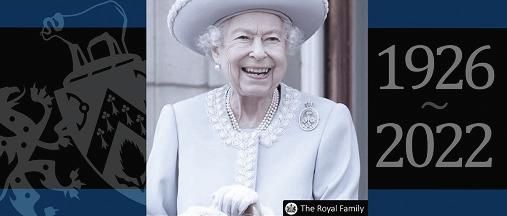
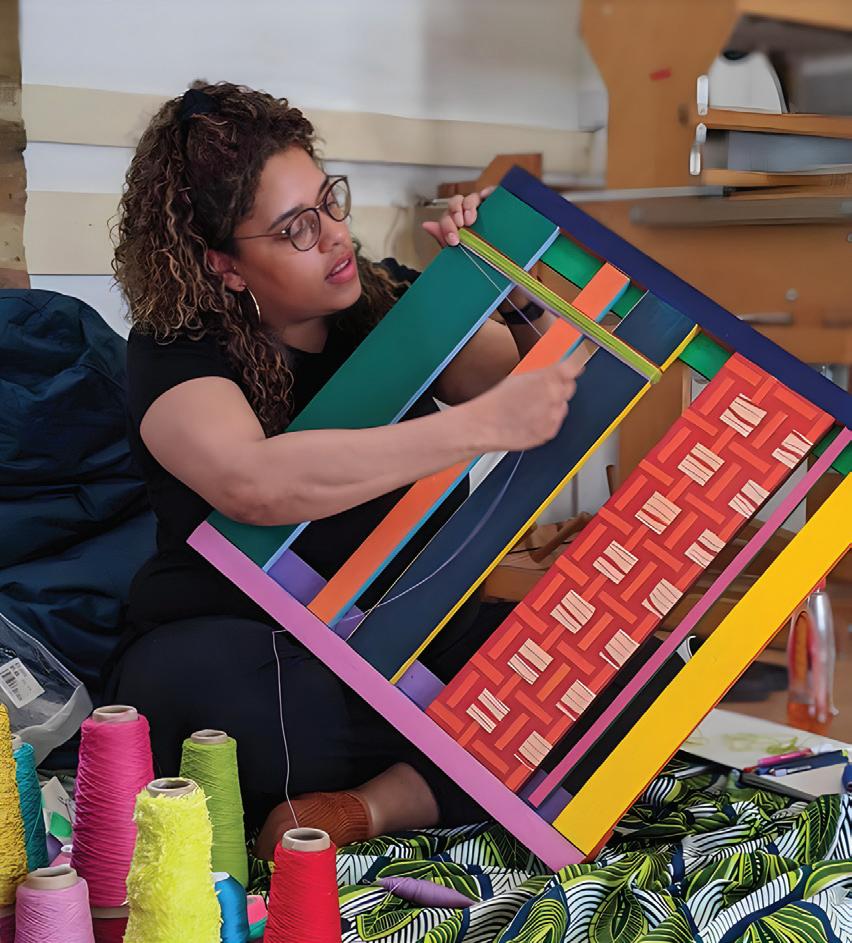
Her Majesty The Queen, who celebrated her Platinum Jubilee in June and died in September, ruled for longer than any other monarch in British history, becoming a much loved and respected figure across the globe. On her 21st birthday, the then-Princess Elizabeth made the following commitment in a wireless broadcast from Capetown: ‘I declare before you all that my whole life, whether it be long or short, shall be devoted to your service.’
The Queen’s coronation took place at Westminster Abbey on 2 June 1952. During her extraordinary reign, she travelled more widely than any other monarch, undertaking many historic overseas visits. Known for her sense of duty and devotion to a life of service, The Queen was an important figurehead for the UK and the Commonwealth during times of enormous social change. She appointed 15 Prime Ministers – fulfilling this duty for the final time during a meeting with Liz Truss on 6 September, at Balmoral. Her first and last Prime Ministers were born 101 years apart.
The Queen had links – as Royal Patron or President – with more than 600 charities, military associations, professional bodies, and public service organisations, in the UK and abroad. Her patronages and charities covered a wide range of issues, from opportunities for young people, to the preservation of wildlife and the environment. The Queen supported and encouraged achievement in all walks of life through the annual programme of Investitures (at which she presented members of the general public with their honours), Garden Parties, receptions and other awards given in her name. These allowed The Queen to say ‘thank you’ to all those who contributed to the life of the nation and the Commonwealth.
Her Majesty carried out all of her duties against the backdrop of a full personal life, which included raising four children, and welcoming grandchildren and great-grandchildren into the Royal Family. The Duke of Edinburgh was – in her own words –her ‘strength and stay’ during her reign, whilst other members of the Royal Family offered vital support through their work in the UK and overseas.
For three consecutive nights, this past September, I walked back to the Hall along The Queue (against the grain), on the south bank from London Bridge to Tower Bridge, observing this curiously British phenomenon as it grew, and millions of people joined it in order to pay their respects to Her Majesty Queen Elizabeth II. On the third and final night, I actually found the back end of it, outside the (old) City Hall, where the stewards were telling people joining The Queue that wristbands were being issued at Borough Market, but there was no guarantee that people would get in before the 6.00 am closure of Westminster Hall.
Up on Tower Bridge, wreathed in bright white and purple floodlights, people were still searching for the end of The Queue. I was able to point them in the right direction. I wonder whether they got to the front in time. I read of one man who queued the whole length, paid his respects, went home for a shower, and then came out and went to the back of the queue to do it all over again. As he said, it was the opportunity of a lifetime. Or, in his case, two opportunities ...
I have had the honour to serve both as 501st and 503rd Master, and I can assure you that the second time is much better! I am enjoying this opportunity to serve, even if the first week of major activities in September was marked by a string of cancellations, occasioned by the sad death of Her Late Majesty The Queen. This had echoes of my first year as Master during the pandemic, when we would plan, advertise and cancel events with regularity. This time around, the majority of Zoom meetings have been replaced with in-person meetings. Although, Zoom continues to have
its uses: more than 50 Clothworkers gathered virtually this past December to join the Crafty Hen workshop and prepare ceramic Christmas ornaments.
This year has been and will continue to be one to remember, not only for the change of monarchs, but also for the changes to Clothworkers’ Hall. No need for me to think of themes or slogans for the year: the decant from our sixth livery hall (built almost 65 years ago) and our alternative arrangements are the main theme this year.
The Great XII Quiz, hosted by The Grocers’ Company, was a brilliant night out for Freedom, Livery and Court members. Although we came eighth in a tightly packed field, I think I shall volunteer for the team next year. On the subject of which, of course, most of 2023 will be spent getting to grips with our new arrangements – whilst Clothworkers’ Hall is demolished and the construction begins for 50 Fenchurch Street and a new livery hall, a process which is likely to take five years. In the spring, we will make the move to alternative offices, possibly on Eastcheap. We shall be holding our Members’ events at The Drapers’ Company, who have a Victorian Hall on Throgmorton Avenue.
In the meantime, I’ve enjoyed seeing so many of you at our very popular events so far this year, and know places will continue to fill up for the final events at the Hall this coming spring. We will be closing the Hall from the end of March,
but there will be a final opportunity to say goodbye to the sixth Clothworkers’ Hall at a Members’ Open Day (proposed for Saturday, 1 April). Many Members have only seen some of the ceremonial rooms and the offices, but there will be an opportunity to explore the corridors, see the kitchens, the silver vault and other parts not generally open to Members, guests and the general public. Further details about the Hall closure, Members’ events, and our move will be circulated closer to the time.
We want to keep Members engaged during this inevitably disruptive period. I’d like to encourage you, please, to continue developing our fellowship by attending events (in person and online), supporting our key activity of trusteeship in your own sphere of activity, and giving to our Clothworkers’ Charity Fund.

I went to see the Crown Jewels in the Tower during the period of The Queue. There was an unfamiliar empty plinth by the exit, where the 1937 Imperial Crown (as well as the 1661 Orb and Sceptre) would normally be located, reminding me that these jewels are not just for coronations. We will likewise have a large void whilst our livery hall is demolished and the new one built. Let us seize the opportunity to be more outward looking, and enjoy the challenge of continuing fellowship in different ways.
My Trust is in God Alone, Alex Nelson, 503rd Master The Clothworkers’ Company
Last July, we reported that we had exchanged contracts with a development partner to help us realise our plans for 50 Fenchurch Street: AXA IM Alts, a global leader in alternative investments. With the contract now complete, we have granted AXA IM Alts a long leasehold of the 50 Fenchurch Street site, and they are preparing to move forward with the development of our new livery hall, a 36-storey commercial tower and improved public realm. Our partners have delivered more than 300 development projects in Europe since 2000, including a flagship project in the City of London, at 22 Bishopsgate.
Designed for us by Eric Parry Architects, we received consent for our planning application in May 2020. The new development will help realise the City of London’s goal for a greener, more environmentally sustainable Square Mile. AXA IM Alts has committed to achieving a BREEAM Outstanding rating and a net-zero development that includes Eric Parry’s innovative design for vertical urban
greening (mitigating air and noise pollution while improving biodiversity).
Located on the southern edge of the City’s eastern tower cluster, 50 Fenchurch Street will provide unfettered river views to the south and south-east over the Tower of London and Tower Bridge, which future visitors will be able to enjoy from a public roof garden. Plans include a new livery hall for The Company, along with the conservation of the Tower of All Hallows Staining and Lambe’s Chapel Crypt, two historic listed buildings currently on the site, which will form part of an extensive new public realm. YardNine is acting as a development delivery partner for the project, with construction due to start in 2024 and delivery targeted for our 500th anniversary (2028).
This past autumn, we have exhibited boards with information and illustrations of our plans for the project to give Members a chance to review the approved Eric Parry designs; we will continue to do this at Members’ events
(where space allows) in 2023.
The support we’ve had from Clothworker Members, Staff and our Professional Advisers has been of the highest order, and we are excited to move forward. From the celebratory and supportive messages we’ve received from many of you, we know you are excited for the next steps too. When complete, the scheme will be part of a new generation of buildings upholding environmental standards, providing state-of-the-art office facilities, and helping to improve the built environment and public space for people living and working in the Square Mile.
But for us, it’s not just an exciting new building development; it is part of our long-term strategy for investing in the future of The Clothworkers’ Company and The Clothworkers’ Foundation. This scheme offers us the opportunity to unlock our assets and increase our charitable impact as we help our communities rebuild from the pandemic and secure our philanthropic legacy for the next 500 years.

My year as Master ended on 20 July. I had a truly amazing year and am immensely grateful for everything it gave to both me and Catherine. We Clothworkers have a truly extraordinary company; as Master, I have learned about it and experienced it as never before.
I am now busy reflecting on the significance of this past year, 20212, for our Company and for our Foundation. The defining day of
‘my year’ was clearly the day after my 65 th birthday: 7 July 2022. At 5pm that afternoon, Hamesh Patel and I signed the documents to complete The Company’s exchange of contracts with AXA – thereby defining the next 250 years’ for the Hall Island Site, or 50 Fenchurch Street, the home of The Clothworkers’ Company since we received our Royal Charter in 1528.
What will The Clothworkers’ Company be like – and indeed the City in which it sits – in the year 2272, when my great-great-great-great-great-great grandchildren will be in their 80s?! I offer you my wish list, which is as follows: That there will still be a Company, a Foundation and a Livery movement in existence.
This may not be the case. I don’t believe livery companies are very widely respected or valued in the country at large, or by governments of all persuasions in Westminster. Twice in the past 150 years, Westminster has threatened our existence. It is down to the leadership of the more prominent livery companies, which includes ourselves, to ensure this perception changes so that we start to receive the respect I believe we deserve.
Assuming we’re still here, then my hopes are that we will consist of the following:
A vibrant community of people who take responsibility for perpetuating our 500-year heritage – by then a 750-year heritage – while enjoying being passionately engaged with The Company, The Foundation and their activities. We have some way to go to achieve this: I estimate that some 60 per cent of us Clothworkers today are actively engaged, but our Membership totals more than 870
people. We worked hard in my year –and continue to work hard – to engage more of you, and it has been fantastic to see how well this has worked – in particular, how well our new All Members’ Party (‘Casino Royale’) went this past May.
Diversity. We will need to be a community of individuals recruited according to merit, incorporating an ever-increasing diversity of women and men, from varied backgrounds –which I sincerely hope will include Members from those families who have been building our organisation, generation by generation, to make it what it is. Our MOVV working group (2021-2) helped us take steps along the path towards this goal.
Achievement of the above requires excellence in investment performance – based on a perpetual timescale. It will be a real challenge for our successors to sustain our recent success rate here, which culminated in signing the financially transformational 50 Fenchurch Street lease agreement. Short-term pain is sometimes inevitable in order to achieve long-term gain, and we must not underestimate the challenges ahead in relation to this project, not least in all the dislocation which that project will cause. Investment success is not usually easy, as most of us know!
Philip Portal, Immediate Past Master
People performing an amazing mission. I hope we will become an ever more major national donor to the most worthy and worthwhile charitable and textile-based causes of the day – in both the UK and in specific corners of the world where the need is greatest. Here I believe we are currently on a good track, with The Company and Foundation cooperating well to achieve our respective objectives.
And be underpinned by savvy investment vision and strategy.
As I handed over the Master’s and my Wardens’ roles to Alex Nelson and his excellent team of Wardens, I reflected on all the work that has happened these past years towards each of the above dreams. Thank you, all, for a fascinating and enormously enjoyable year. It has been a true privilege to represent The Clothworkers’ Company externally on countless occasions – at remarkable events throughout the City, and at fascinating talks and performances, which have included Her Late Majesty The Queen’s Platinum Jubilee Service of Thanksgiving at St Paul’s Cathedral and the Platinum Jubilee Concert in front of Buckingham Palace. And thank you, not least of all, for your trust in appointing me to lead the Court through the previous year of major decisions and change.
I would like to thank our loyal and talented Staff, on every level, for all your remarkable work and support. And also each of our many Members who have worked tirelessly with immense skill to enable this year to have been so productive.
We have a truly remarkable company, with the opportunity of a terrific future ahead.
“We have a truly remarkable company, with the opportunity of a terrific future ahead.”
The recent cataloguing of the first 10 volumes of the Quarter Wardens’ bills and receipts in The Clothworkers’ archive has revealed a significant number of itemised gardeners’ bills. These provide a wealth of information regarding the form and function of the gardens of Clothworkers’ Hall and at The Company’s almshouses in Islington.

Previous studies of Clothworkers’ accounts have uncovered details of the Hall gardens during the 16th and 17th centuries. For example, they document the planting of a vine in 1530-31, which had grown to cover one of the brick walls by 1611. Eglantine, hyssop, rosemary, winter savory and thyme were also planted, and these would have filled a formal knot garden. The Germander speedwell, with its delicate blue flowers, would have added to the display.
Treswell’s watercolour survey of The
Company’s properties was undertaken in 1612; it is one of the most important treasures in our archives and also provides information on the gardens. The survey depicts a walled garden of just under 4,000 ft2, with two formal knot designs in the centre. The garden was positioned behind the Hall, and the parlour and was overshadowed by the church of All Hallows Staining. This layout, with the garden to the rear of the Hall and adjacent to the parlour, was also typical among other livery company halls during the 17th century.

In the years following this survey, little research has been conducted into how the garden evolved. The Second Hall was replaced by the Third Hall in 1633, then this building and presumably the garden were destroyed in The Great Fire of London in 1666. However, it is not known how the garden changed during this period or how it was redeveloped when the Fourth Hall was built in 1668.
By examining the bills and receipts to look at the routine work of the gardeners and some of the materials they used, we can begin to understand how a subsequent garden may have developed. Typically, the tasks of the gardener were:
‘… Looking after the garden, cutting the vines, Mowing the Grass Platts [plots], watering and cleaning the Garden three times a Week during the Summer Season, & for [planting] several Annual Plants Roots & Flowers for one year …’
From this account of the regular maintenance undertaken, it can be concluded that vines grew along the walls and there were areas of grass lawn. The bills also show that pathways had been created from gravel and there were borders that were regularly fertilised with leafmould.
A large number of box, yew and holly trees were purchased for the garden,
however it is unclear whether they were used for hedging or placed in decorative pots. It’s possible that the garden of the Fourth Hall again had a formal layout, similar to that surveyed by Treswell. If so, it is likely that the clipped topiary, fashioned into geometric patterns, was constructed from box trees.
The function of the garden appears to have been mainly for display and enjoyment. In the 17 th century, there was an established understanding that gardens were a place for recreation. Often they included bowling alleys and tennis courts, although The Clothworkers’ Company tennis court was situated separately on Fenchurch Street. The bills and receipts for 1694-1750 allude to the purpose of the Hall’s gardens being largely decorative – more than 65 varieties of plants and shrubs were documented. The most frequently mentioned were roses, honeysuckles, sweet Williams, daisies, French and African marigolds and Canterbury bells. Other familiar varieties included stocks, violets, primroses, carnations, tulips, cornflowers, snowdrops, wall flowers, nightshade, lilies and sweet peas. Occasionally, the bills also mention the colours or varieties of the flowers: blue, yellow and white lupins were planted as well as red and white daisies. It would have both vibrant and fragrant.
However, the garden was also productive. Culinary and medicinal herbs such as rue and camomille were planted, possibly filling a knot garden. Scarlet beans, apple trees, fig trees and vines also featured, and these would have been used for ingredients in the Hall kitchen.
Finally, the bills and receipts also contain information about gardens at The Clothworkers’ almshouses in Islington. These almshouses had a diverse orchard planted across three
Facing page: Sample gardener bill CL-D-7-01 476 (left) and an artist’s reconstruction of the Second Hall and gardens (right). This page: Excerpt from Treswell’s watercolour survey, featuring Clothworkers’ Hall.
gardens. In 1727, the existing area was leveled to allow for the planting of a large number of trees: 41 peach/ nectarine, 17 apricot, 23 cherry, 17 pears and 20 plums. The following year, 29 limes were also added. At the time, areas outside the City wall became associated with productive gardening and the almshouse orchard to the north of the City supports this observation.

In this sample of just over 50 documents, a picture of how the Hall garden might have looked begins to emerge. Further research into later bills and receipts could reveal the evolution of this large urban garden
over the following 100 years until 1860, when it was finally buried under the structure of the Fifth Hall.
This research has been made possible due to detailed cataloguing of more than 7,500 warden’s bills – undertaken by the archive team during lockdown – and is just one example of the research possibilities this wonderful series in our archive offers. Detailed descriptions, together with a sample of more than 700 photographs of the chits, were added to The Clothworkers’ online catalogue this past autumn. You can find our online catalogue on our website at www.Clothworkers.co.uk/History


The Experimental Weave Lab (TEWL) launched the City of London’s first contemporary, innovative weaving season when it opened in April.
Curated by Elizabeth Ashdown MA RCA and Philippa Brock MA RCA, this temporary programme has included short- and long-term weaving residencies, talks and workshops, exhibitions, and more that explore the experimental, interstitial spaces in which weavers are working throughout UK craft, research, art, design and industry.
Our grant has funded the start up costs of the Lab, loom delivery and return, insurance, residents’ stipends, and necessary materials and sundries to operate. The stipend payments have allowed TEWL to invite a range of diverse weavers for residencies of one month or longer, enabling them to concentrate on making new experimental work, improving social media and communication, host regular Open Lab days, share the work being developed with the public and other weavers, produce outreach workshops for young people, and hold online talks.
TEWL introduced the notion that labs/studios/incubators can be effective in facilitating the development of new ideas, which can then be progressed and translated into the varied UK weave industries, while not neglecting endangered crafts, such as passementerie (there are only four to five known hand passementerie weavers in the UK).
Two of the Lab’s first residents, Amber Roper and Sarah Ward, have gone on to run three highly successful weekend weaving workshops with young people in The Brady Centre, Tower Hamlets. They were assisted by two Central Saint Martins Weave Students, who are currently on their placement year out; these students participated in this same arts and design outreach scheme as teenagers.
Sarbjit Natt, the Director of the ‘A’ Arts Team at The Brady Centre has said: ‘I want to take this opportunity to thank you for setting up this amazing project and arranging for Amber and Sarah to deliver their fantastic and inspiring workshops for us. Work created by young people has been outstanding and so wonderful ... It has motivated and put weaving on the list of preferred options for studying.’
The Brady Centre is a partner for the ‘A’ Team (an outreach programme working with universities and fashion and design studios, including Alexander McQueen).
More information about TEWL and its forthcoming programmes can be found on the website at www. TheExperimentalWeaveLab.co.uk.
The Company is delighted to act as a host and co-sponsor to TEWL (alongside The Mercers’, Drapers’ and Weavers’ Companies as well as the City of London). We offered TEWL the use of our St Olave’s Parish Hall on Mark Lane, right outside Clothworkers’ Hall, until January 2023.
Facing page: Sally Holditch, resident from The Experimental Weave Lab and our representative at the Livery Fair during the London Sheep Drive (September).
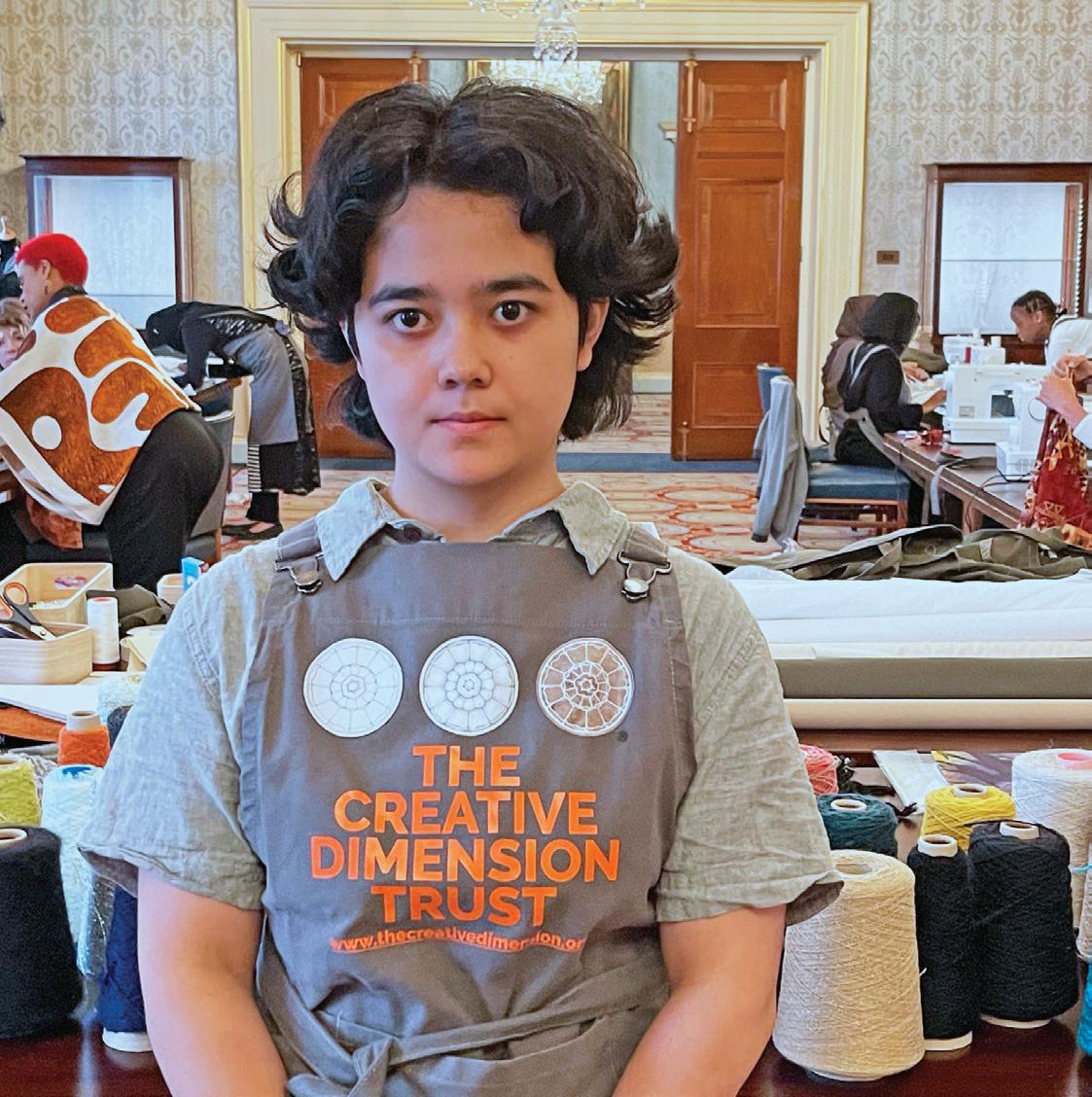
The Creative Dimension Trust is an arts-based charity that works with young people – largely from disadvantaged backgrounds – to nurture their interest in and develop their talent for craft skills. It received another grant from The Company in 2022 in support of four inspirational new workshops. TCDT kicked off the year with ‘Contemporary Couture Embroidery’ in partnership with Hand & Lock in London.
In August, Clothworkers’ opened up the Hall to host The Trust’s next two workshops. The generous size of the Hall allowed two courses to run simultaneously, and we witnessed firsthand the talent pouring from the young participants. Weave It: An Introduction to Table Loom Weaving was led by former Clothworkers’ Award bursary
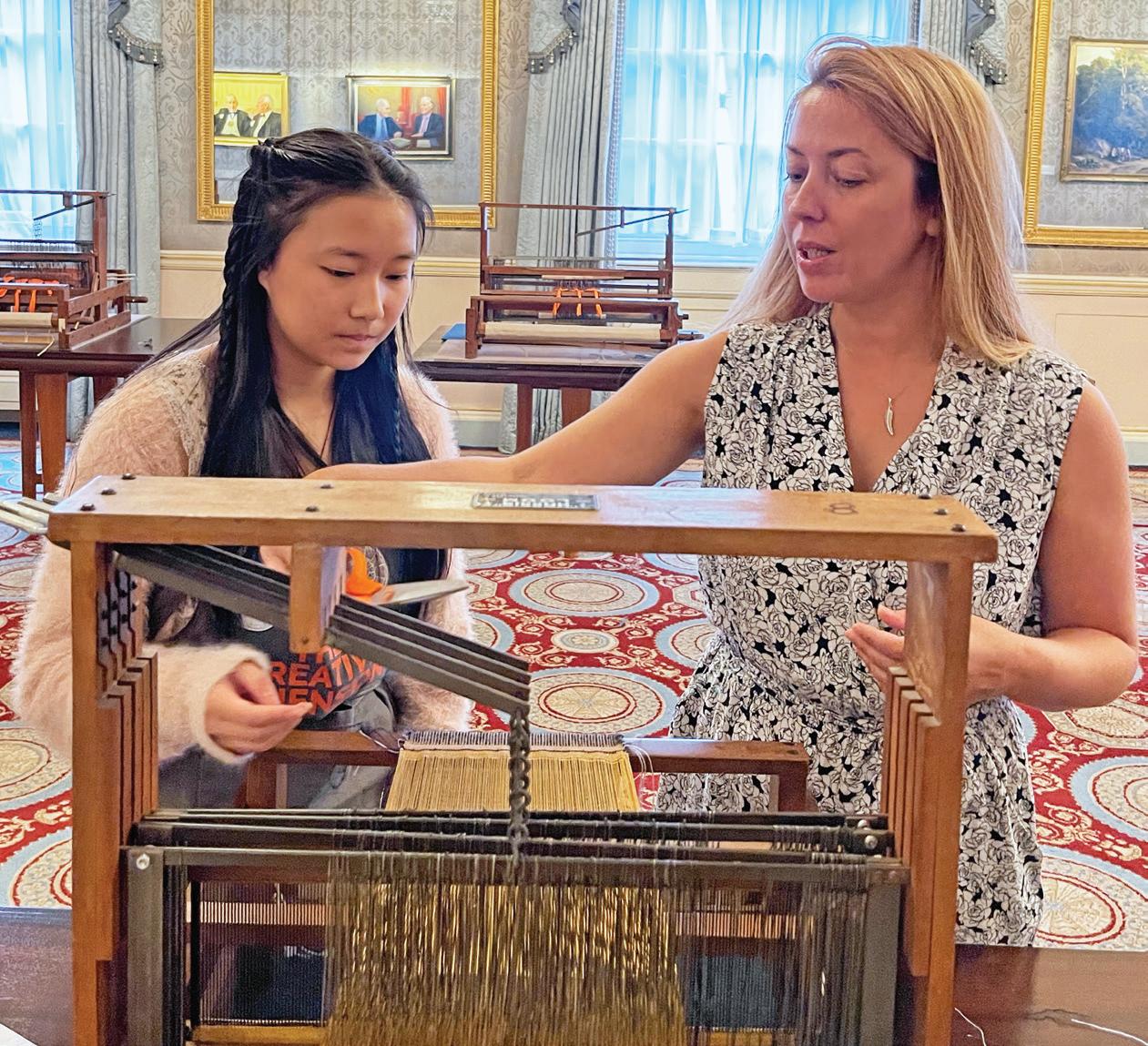
recipient Claire Whelan, who held a two-year residency at Cockpit Arts. Claire is now an entrepreneur and currently teaches at London Metropolitan University. The images featured here illustrate the Weave It workshop and its participants.
Sewing & Dressmaking was led by José Hendo, a Ugandan-born British eco-sustainable designer and Founder of the José Hendo brand, Bark To The Roots (B2TR) initiative and the R^3 Campaign. José promotes the use of organic, eco-textiles and recycled materials to create unique – often avant-garde – garments, and accessories for both women and men.
During their week working in our Hall, students were also treated to a tour of the building and collections, including the silver vault, by our own
Head of Collections and Archives, Jessica Collins.
In the autumn, the Trust went on to provide a workshop on embroidery with our grant, and will return to Clothworkers’ Hall once more in the new year. The lecture ‘Ceremony and Splendour: A History of Coronation Dress and Jewels’ will be given by Caroline de Guitat, Deputy Surveyor of The King’s Works of Art on Monday, 6 March 2023 (18.30). This event will be open to the general public, and tickets (£25 per person) will include a glass of Fortnum & Mason champagne with 100% of proceeds going to support TCDT’s work with young people. Find out more and book your tickets from The Creative Dimension Trust website: www.TheCreativeDimension.org/ Fundraising/Ceremony-And-Splendour.
A charity that enables young people to work with leading global specialists and develop fine handskills that will inspire future careers
“We want to thank all the students, Claire Whelan and everyone at Clothworkers’ Hall who helped make this possible, it was a truly enjoyable project to witness everyone take advantage of this opportunity and enjoy themselves, while learning a specialised skill that they can take with them.”
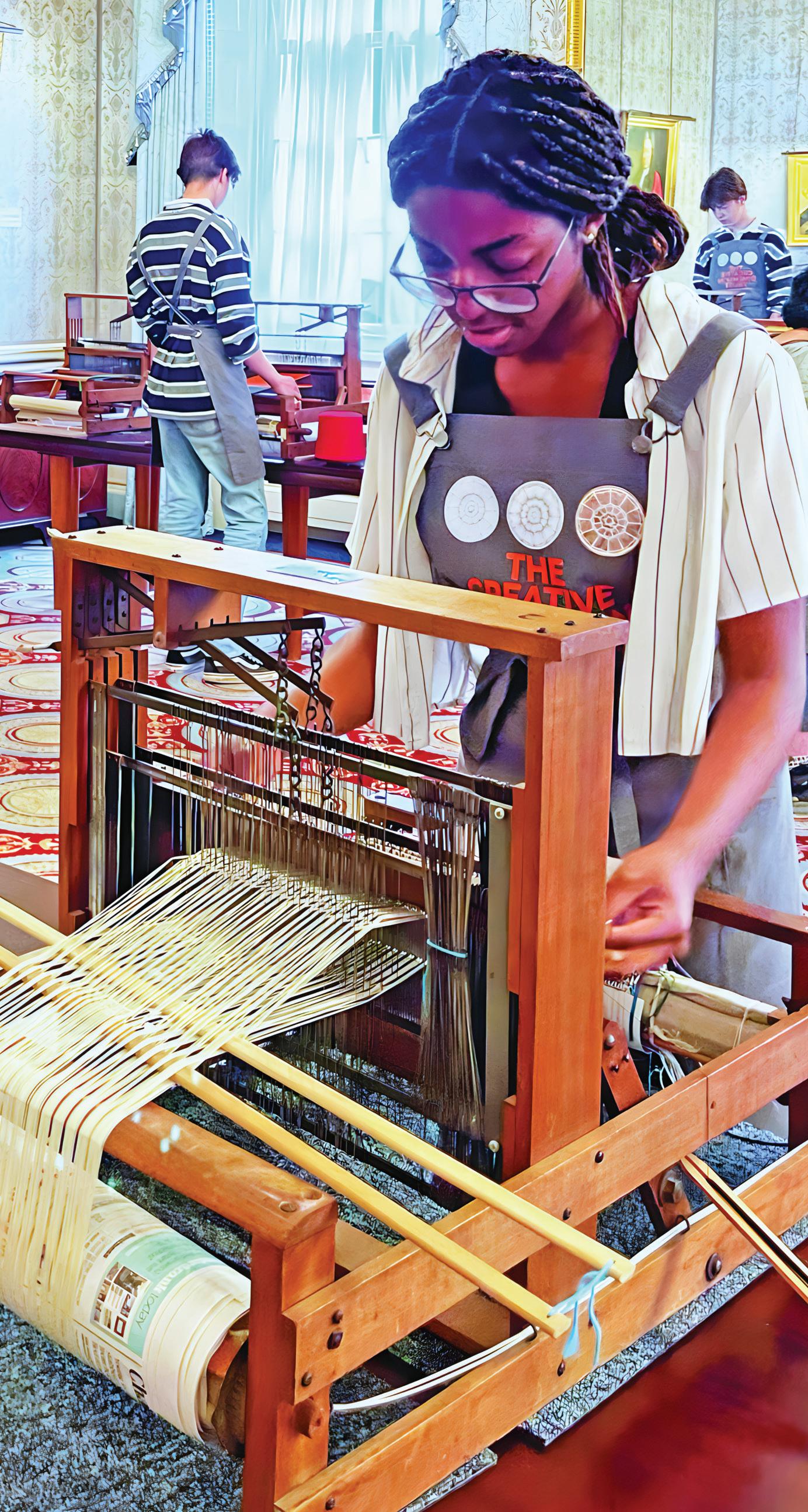
The Bradford Textile Society’s annual Design Competition, with total prize money of over £17,000, is unique in its breadth of coverage, and attracts almost 1,000 entries from students throughout the UK.
In recent years, the competition has been successfully judged remotely. Clothworker Emily May, a textile designer, once again volunteered to help review the entries in the six categories we support – each has a winner as well as prizes for second and third places, and for special commendations. The 2022 winners were:
A Knitted Fabric for Either Fashion or Interior Products: Daisy Lawrence, De Montfort University (£500)
A Printed Textile Design for Either Fashion or Interiors, Which Shows Creative Potential: Megan Clift,
Falmouth University (£250)
A Woven Fabric Design for Fashion or Accessories: Aimee Zanetti, De Montfort University (£500)
A Woven Fabric Design for Interior Furnishings or Products: Katie Cutler, Manchester Metropolitan University (£500)
A Fabric Design for Either Fashion/ Accessories or Interior Products, Which Shows an Innovative Combination of Textiles Processes: Amy Gardner, Loughborough University (£500)

A Material Construction, for Fashion/ Accessories or Interior Products, Produced by Non-Conventional Processes and/or Materials or by New Technologies: Leyla Kuman, De Montfort University (£500)
Below: A preview of work submitted by Daisy Lawrence, who focused on forgiving, stretchy knitted fabrics that recognise the stigma surrounding non-traditional bodytypes, but also celebrate and accentuate curves rather than hiding them away.
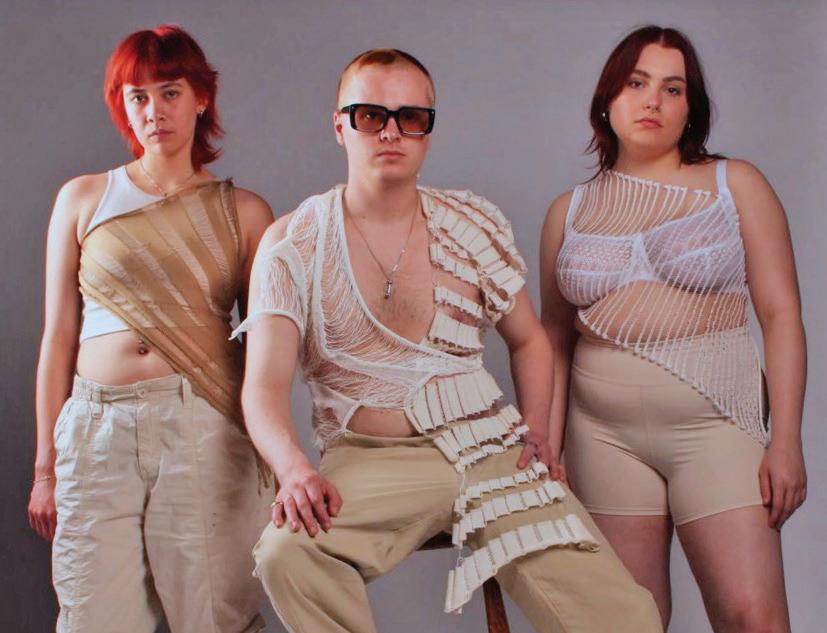
Congratulations to Emilie Harford, who received The Clothworkers’ Company Associate Prize for Printed Textile Design at New Designers this year. Emilie is a forward-thinking surface and textile designer with a diverse practice, largely driven by conceptual thinking and ideation. Her design process is deeply influenced by an awareness of the need for industry-wide sustainable change and improvements in transparent practice. Conscious sourcing of materials and fabrics is fundamental, as is the consideration of more sustainable technique alternatives. Emilie particularly enjoys working with a handson approach, investigating innovative textile and material applied processes.
The project exhibited at New Designers was called ‘Space Denim: An Investigation into Denim, Exploring the Possibility of Sustainable Reinvention’. The visual theme of space discovery was interwoven to emphasise ideas of innovation and revolution.

Upon receiving news of her achievement, Emilie wrote, ‘I loved being part of New Designers and having the opportunity to present my work to a wider audience. I really enjoyed discussing my projects with industry professionals; it was so rewarding to have such positive feedback. I am absolutely delighted to have been awarded The Clothworkers’ prize, especially considering how high the standard of all the other work was, and I am looking forward to whatever comes next in terms of starting my career’.
The Clothworkers’ Associate Prize was judged by Clothworkers Emily May (Textile Designer and former New Designers’ prize winner herself) and Cherica Haye-Zimmerman (Material Design Director of Kids Footwear, Nike Inc.).
You can read more about Emilie’s work on the New Designers’ website at www.NewDesigners.com.
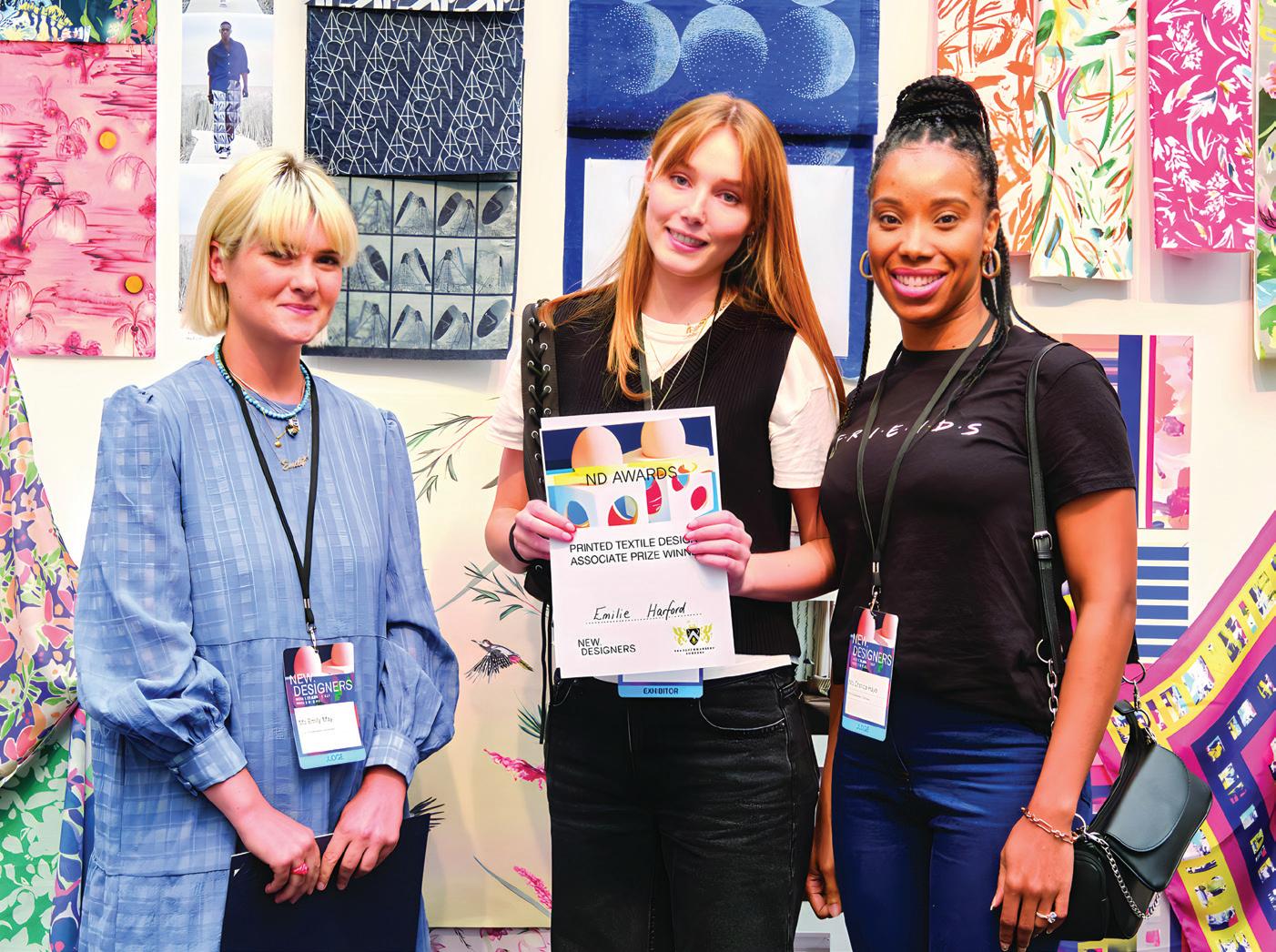
“I am so honoured to show my work at [The Clothworkers’ Company] with [Bishopsland Educational Trust]. I would never believe that I would show my work with all these amazing makers and artists. I feel so lucky to be able to be part of this show and this year’s gang, as all of them are all such amazing people. ”
 Moravarid Alavifard, Bishopsland Fellow
Photography by Julia Skrupny
Moravarid Alavifard, Bishopsland Fellow
Photography by Julia Skrupny
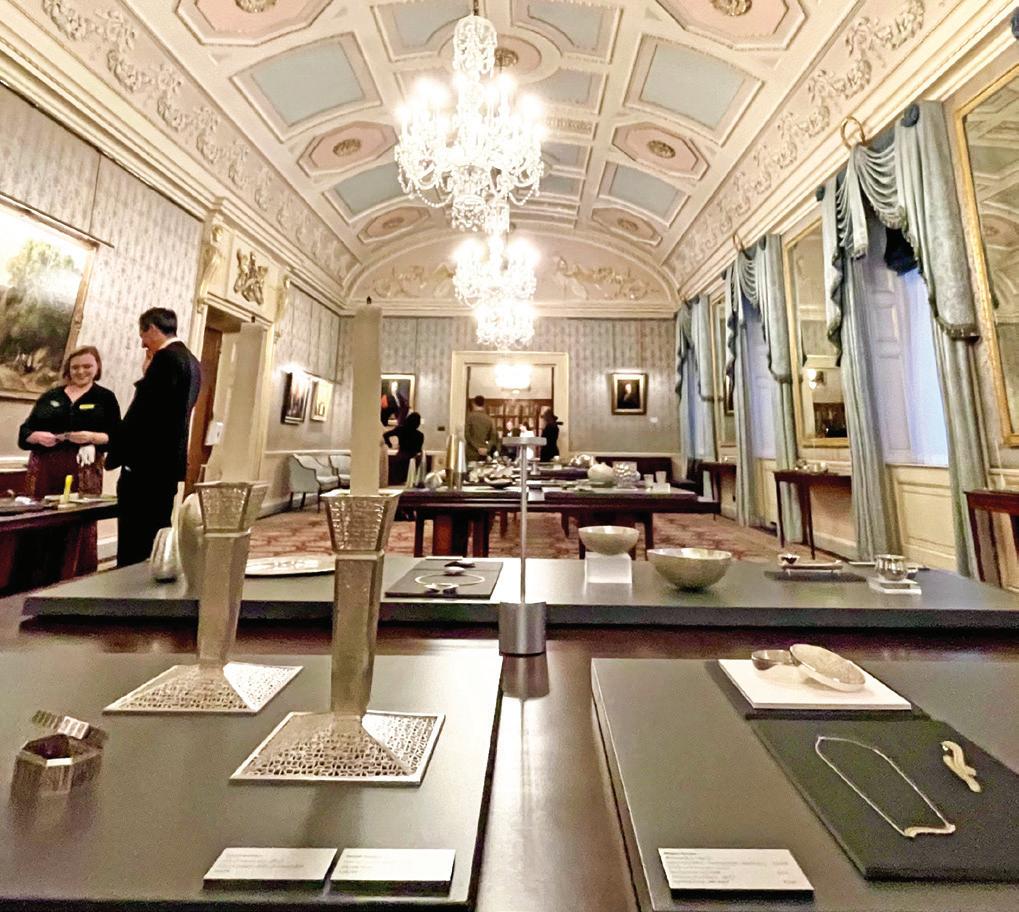

The Clothworkers’ Company was delighted to host the Bishopsland Educational Trust at Clothworkers’ Hall in November. The programme, which provides a one-year residential postgraduate course, is the only postgraduate residential facility in the UK for emerging silversmiths and jewellers. The Trust, which will celebrate its 30 th anniversary next year, used the Hall for an exhibition
and sales fair for its students and Fellows.
The exhibition at Clothworkers’ Hall was among the earliest opportunities some of the rising talent has had to present their work in public. The free event included fascinating lectures from Dr Tessa Murdoch (‘Institutional Patronage and the Clothworkers’ Approach to a Special Commission in the Past and Present’)
and Dr Dora Thornton (‘Supporting Contemporary Makers: Recent Acquisitions for The Goldsmiths’ Company Collection’).
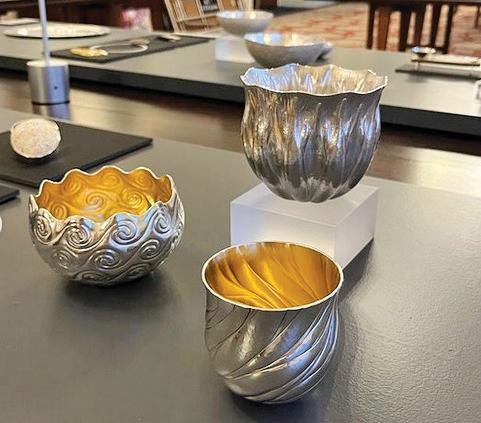
You can see more work from Bishopsland Fellows through their virtual Christmas exhibition and sale: Bishopsland.org.uk/Shop/.
Proceeds from sales went to support the Bishopsland Educational Trust.

Thomas William Wing was a key benefactor to The Clothworkers’ Company. Upon his death on 7 March 1889, he left £70,000 in trust to The Company, a substantial sum of money that probably equates to more than £6m today.
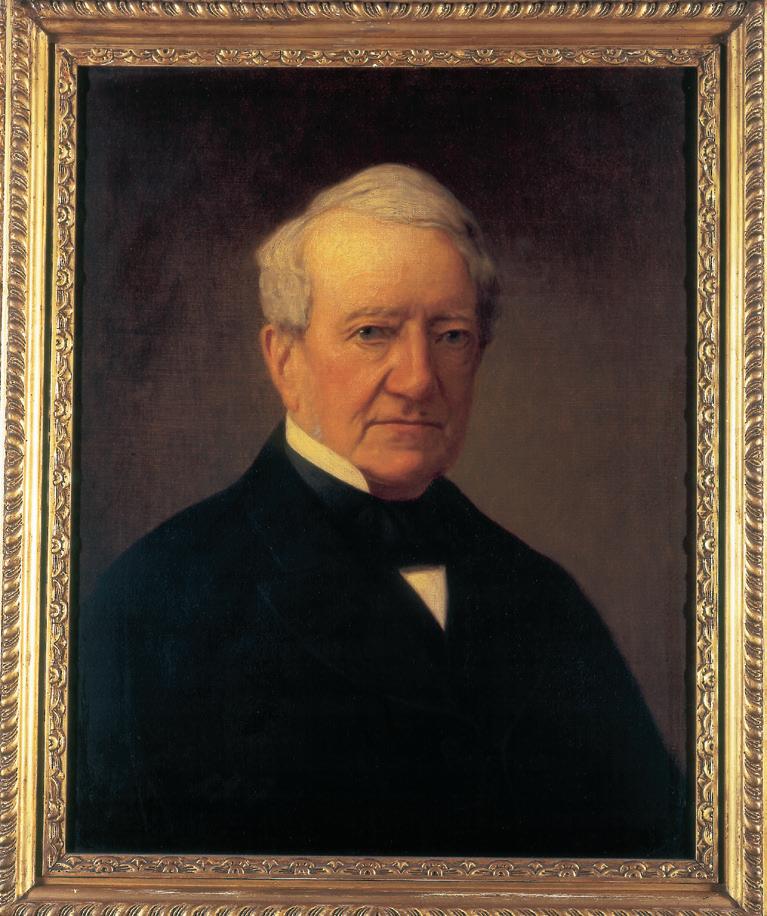
His bequest was to provide annuities or pensions of £20 each for blind persons, regardless of their age or sex, and the recipients were known as ‘Wing’s Pensioners’. The Company already had a long-standing tradition of support for the blind and visually impaired –having become trustees of nine separate charitable trusts established by John and Frances West more than 150 years earlier.
Wing is commemorated in Nunhead Cemetery (South London), where a large memorial was erected in his memory. However, despite his obvious wealth, little is known of his life, and he declined an invitation to serve as Master in 1869, due to ill health. We must piece together his story from surviving traces in the archives.
Wing was born on 19 August 1802, in the Parish of Saint Mary Rotherhithe. The son of a stone mason, Thomas Wing, he first features in The Clothworkers’ Company records when his apprenticeship was registered on 6 November 1816. He was apprenticed to Michael Roberts, a grocer by trade, who was based in the parish of St Mary at Hill (only a short walk from Clothworkers’ Hall).
Thomas successfully completed his apprenticeship and became Free of The Company in 1823. At the time, he described himself as a grocer in Rotherhithe Street. Just three years later, he took on his own apprentice, Robert James Rushbrook; our apprenticeship register says he was based at 26 Little Eastcheap. By the time he took on a second apprentice in 1848, he was a member of the Livery.
The Clothworkers’ archives are otherwise silent on Wing’s career; however, the Proceedings of the Old Bailey online provide some tantalising references into the trials and tribulations of his business life. Whilst based in Eastcheap, Wing was the victim of two crimes. In 1841, a William Scarsbrook was indicted for stealing 56 lbs of raisins from Wing’s warehouse. The second crime, in 1851, involved one of Wing’s own employees; James Sanderson was witnessed by a policeman giving bags of coffee stolen from the warehouse to a female accomplice, Sarah Green. The police then found other stolen goods (likely also from Wing’s warehouse) in Green’s possession, including nutmegs, sugar, Spanish juice, four strings of figs, and some ginger. Sanderson pleaded guilty and was sentenced to six months in prison. Interestingly, both Scarsbrook and
Green were declared not guilty. Could Wing have intervened to ensure they were shown clemency? Indeed, it might be the case that these brushes with the law led Wing to re-evaluate his career path: Once he retired, he left London and became a Justice of the peace in Suffolk.
Wing never married and, in his retirement, lived in a household with his younger sister, Rebecca Bates Wing, and four servants. Rebecca was made Free by Presentation in 1889, shortly after her brother’s death. Later the same year, she presented The Clothworkers’ with a fine set of five silver gilt finger bowls, intended for the use of the Master and four Wardens of The Company.
Alongside his generous charitable donation for The Clothworkers’ Company to administer, Wing presented The Company with a large standing cup in 1877, and also donated smaller sums to the City of London Hospital for Diseases of the Chest, the East Sussex Hospital, and the Royal National Lifeboat Institution.
The Thomas William Wing Trusteeship was transferred to The Clothworkers’ Foundation in 1980, and later consolidated with other trusts for the benefit of blind people.
One of five silver gilt fingerbowls.
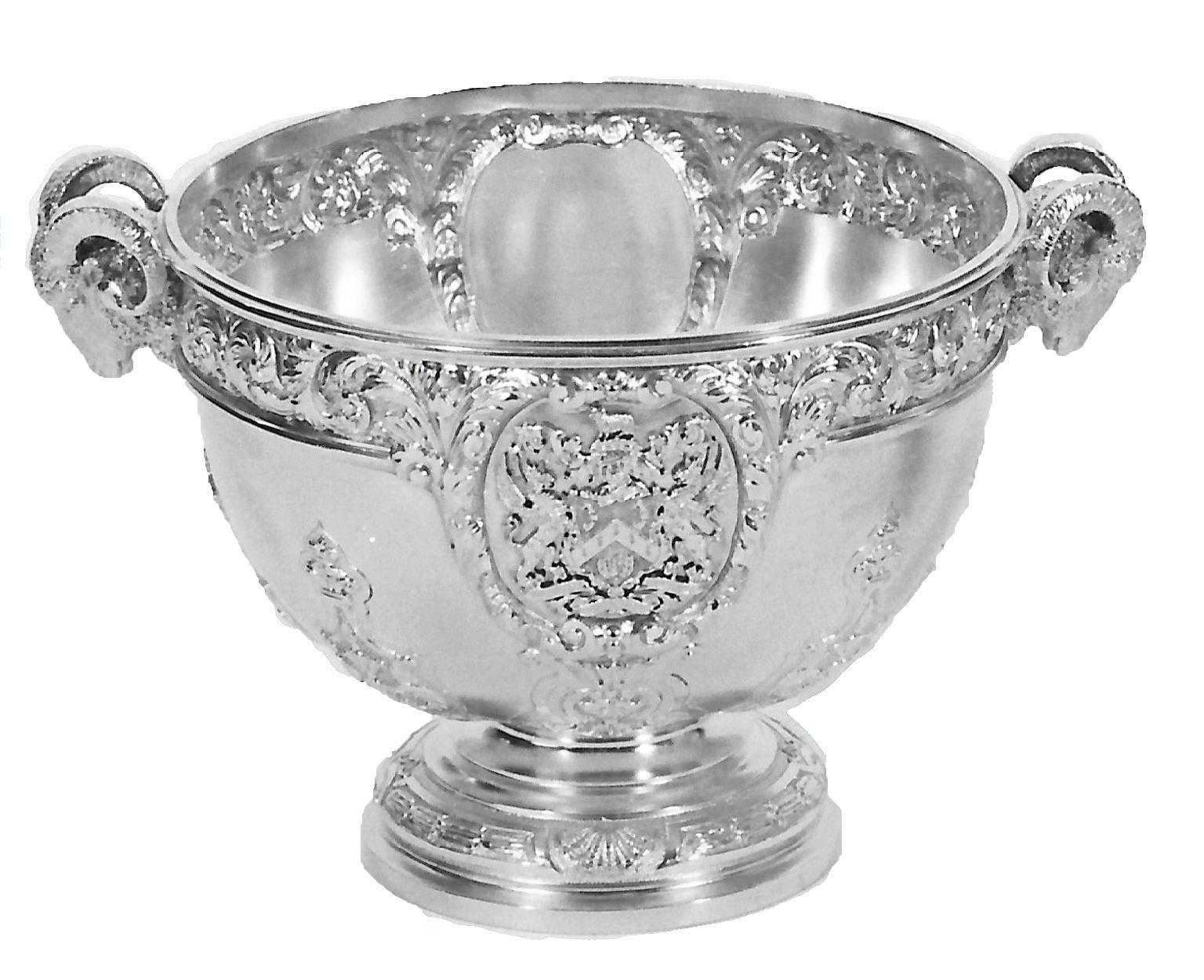
In a conversation with the Clerk, I happened to mention that my lawyer had done a great job tidying up my will and reducing the amount of my estate liable to tax. A particular point that interested him was introduced by George Osborne in a budget that was of great value to charities; Jocelyn has asked me to write this down as it may have considerable value to The Clothworkers’ Company. The point is this – after all other deductions have been taken into account, including the basic allowance, tax is normally payable at 40 per cent on the remaining net sum. Osborne produced an additional concession for those prepared to leave 10 per
cent of this net sum to charity, and the result is remarkable. While it has the same effect on any size of net estate, I set out two examples below.
Let’s say you left £1 million (this is a figure easily reached when today’s property values are taken into account). Here the tax is £400,000, leaving £600,000 to one’s beneficiaries.
If £100,000 is left to charity, the tax rate falls to 36 per cent on the remaining £900,000, so the tax payable is reduced from £400,000 to £324,000 while the beneficiaries receive £576,000. The result is that the charity receives £100,000, but the net loss to the beneficiaries is only £24,000.
The same calculation applied to a £500,000 net estate results in £50,000 going to the charity at a cost to the beneficiaries of only £12,000.
My conversation with the Clerk inevitably drifted on to The Foundation. Our Foundation has a great advantage over almost any other charity in that bequests to The Foundation are applied to the capital, growing over time and helping increase The Foundation’s financial position – and its impact – year on year. Whereas, a donation to another charity is usually spent immediately on the charity’s mission costs – this may be meaningful, but achieves a more short-term impact.
Leaving a legacy to The Clothworkers’ Foundation will allow future Clothworkers to build on the philanthropic achievements of the nearly 500 years of Clothworkers’ history – including close to 50 years of The Foundation. It is a wonderful way to recognise the part that The Clothworkers’ Company has played in your life.
Legacy gifts are easy and tax-efficient to set up. A promised and documented legacy during a donor’s lifetime redoubles its value now and for the future.
A will is an important document, and it would be wise to seek legal advice when considering available options. The content of a will is a private matter and, whilst helpful, there is no expectation that intentions need be communicated
to recipients in advance.
There are three types of gift that we think would be relevant to those wishing to leave a bequest to The Company and Foundation, which may be included in a will or a codicil (an amendment) to an existing will:
(1) a Residuary Legacy is the gift of some or all of the remainder of an estate;
(2) a Pecuniary Legacy is a gift of a specific sum;
(3) a Reversionary Legacy allows a specifically-named person to benefit from an estate (or part of it). Upon death, the legacy would pass, for example, to The Foundation.
The Clothworkers’ Foundation is, of course, a registered charity (274100). This means that all legacy gifts to The Foundation are currently exempt from

UK Inheritance and Capital Gains Tax.
Under present rules, if 10 per cent or more of a chargeable net estate is left to charity, the Inheritance Tax (IHT) rate on the whole of the taxable estate is reduced from 40 per cent to 36 per cent. Of course, rules may change, and professional advice should be sought by Members before any commitments are made.
The Clothworkers’ Company and The Foundation are grateful to all Members, and their families, who are considering this matter. An exploratory, and confidential, conversation with the Clerk may be helpful to discuss your intentions or answer your questions. Please make arrangements by emailing Emma Temple (EmmaTemple@ Clothworkers.co.uk).
Volunteer as a Clothworker Judge or as an Advocate with Inspiring Connections
Sign up to become part of a programme that provides personal and professional development to help young people – providing them with the opportunity, support and momentum to take the next steps in achieving their career goals. The Company is a founding sponsor of Inspiring Connections (in partnership with others), which is delivered by the charity Catch-22.
“They created a safe space, which generated some great dialogue. The team is engaging, friendly, professional and supportive of both Candidates and Advocates.”
Inspiring Connections usually involves a brief six- or eight-week commitment with a variety of group and one-onone sessions with participants. The next programmes are running from 12
January to 16 February (13.00-15.00), and from 15 February to 22 March (18.30-20.30). As an Advocate, you will use your experience and interpersonal skills to support Candidates to build the confidence, aspirations and networks they need to achieve their career goals. The only pre-requisites to being an Advocate are having a professional story to tell, an openness to sharing your experiences and a desire to support others who may have had fewer opportunities than yourself. Complete the online form to register for an
Advocate place. You don’t have to have previous experience supporting people into work or mentoring, as training is provided.
The programme initially started by recruiting livery members to serve as Advocates, but has become so successful that both TikTok and Microsoft have encouraged their teams to give back and volunteer with the programme.
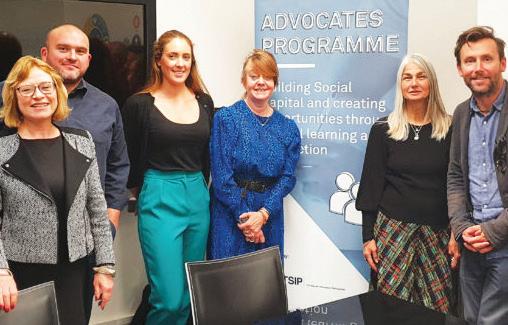
Find out more at: www.Catch-22.org.uk/ About-Inspiring-Connections.
We are recruiting Clothworkers to help from 15 to 28 February, supporting the first round of judging for the annual Charity Governance Awards Clothworkers have always been and continue to be essential to the judging process. To volunteer, please sign up at: www.SurveyMonkey.co.uk/r/ CGAJudge_2023.
Can you help spread the word about the Charity Governance Awards to your network? The awards are free and easy to submit online: www. CharityGovernanceAwards.co.uk.


This past summer, The Clothworkers’ Foundation recruited two new Trustees to the Board: Amir Rizwan and Clothworker Hugo Slim. Our charity governance partners and third-sector recruitment specialists, Prospectus, helped us with our search for a new Clothworker to join the Board, as well as someone unaffiliated with The Company. Both new Trustees will play a vital role in providing strategic insight and sector understanding as well as ensuring the right blend of support and constructive challenge to our Foundation Board, the Chief Executive Officer, our Grants Team, and The Company’s Court of Assistants. They will also be key to helping The Foundation take forward the recommendations from its recently completed Strategic Review.
Amir is Big Society Capital’s Investor Relations Director, leading on relationships with trusts and foundations, supporting them in their work around missionled investments as well as how impact can play a role within their endowment investments. He also leads the organisation’s work around partnerships and

innovation, focusing on the development of early-stage impact funds to tackle UK social issues.
Amir has been working in the social investment sector for eight years and recently led on Comic Relief’s social investment strategy. Prior to that, he managed a community housing investment fund for CAF Venturesome, as well as a portfolio of social investments for a range of social purpose organisations.
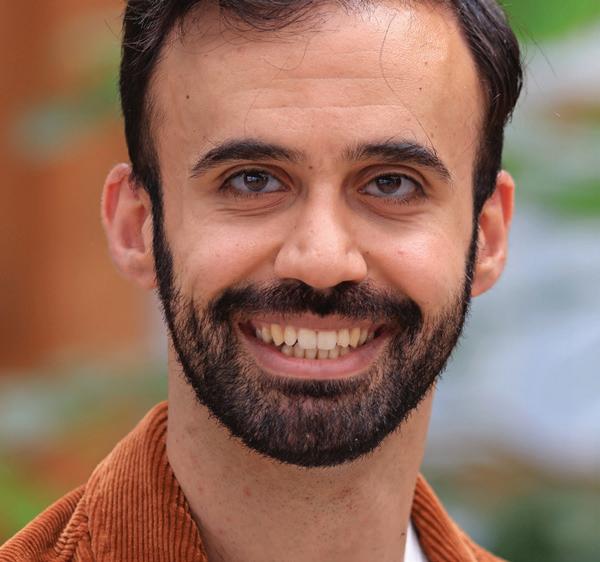
Through his role at Big Society Capital, Amir is a member of the Social Impact Investing Group (SIIG). He also sits on the Impact Advisory Board for the Growth Impact Fund. Prior to joining the social investment sector, Amir worked in the financial services sector in a variety of roles for BNP Paribas and Royal Bank of Scotland. Amir is currently the co-chair of the Diversity Forum (set up to improve diversity, equality and inclusion within the social investment sector) and a Governor at the Cripplegate
Foundation in Islington.
Aside from his role as a Clothworker, Hugo has worked in international aid since 1983; he moved between operational agencies and universities, with a particular focus on the ethics of war and humanitarian aid. He has worked for the International Committee of the Red Cross (ICRC), the Centre for Humanitarian Dialogue, the United Nations and Save the Children, and has been a trustee of Oxfam GB and the Catholic Agency for Overseas Development (CAFOD). As an academic, he has held teaching and research positions at the University of Oxford, Oxford Brookes University, Tsinghua University, the University of Oregon and Geneva University. He is currently a Senior Research Fellow at the Las Casas Institute for Social Justice at Blackfriars Hall (University of Oxford), where he is researching climate emergencies.
“I am delighted to be joining [The Clothworkers’ Foundation] at such an important moment in its history, and am especially looking forward to working to reduce poverty and exclusion in the UK after spending so many years focused on similar challenges around the world.”
Hugo Slim, Livery Member
Wing Commander James Sjoberg, RAF 47 Squadron

In the top-left, Master Alex Nelson greets our RAF guests before the lunch begins. Below that, Court Assistant Mary Ann Slim celebrates with award recipient Sergeant John Hoskin. On the bottom, all award recipients pose for a photo with the Master and Wing Commander James Sjoberg.
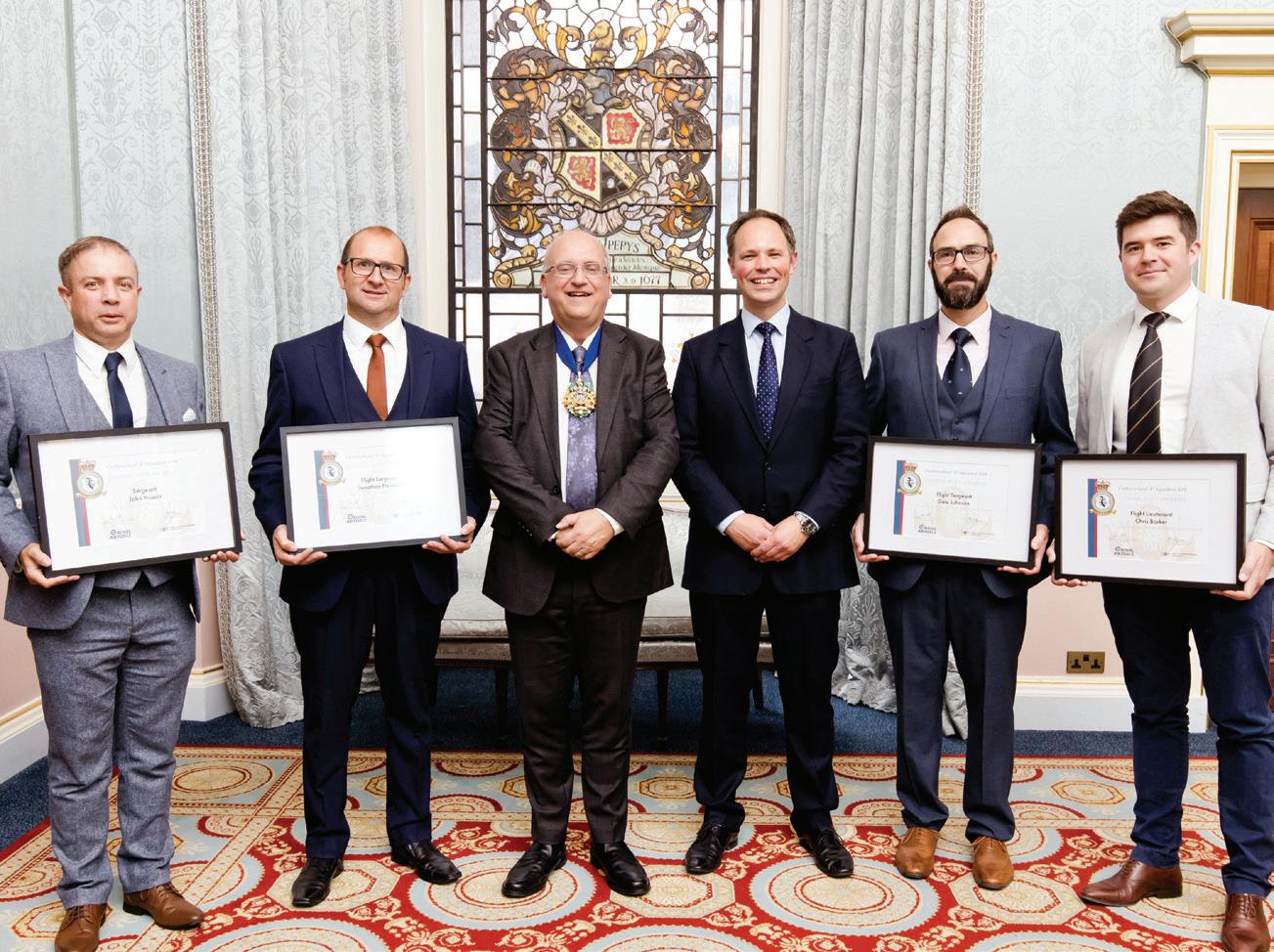


“You gave us a fantastic welcome to Clothworkers’ Hall ... Thank you so much for hosting us.”
“We are forever grateful for the support and friendship you have shown us and hope to keep up our affiliation long into the future.”
The Clothworkers’ Company is proud to have supported 47 Squadron for the past decade or more. In addition to opportunities to meet and develop relationships with service men and women, The Company is delighted to fund annual community and family welfare activities and special opportunities for the Squadron. For instance, we sponsored the memorial sculpture at the National Memorial Arboretum, commemorating the Squadron’s centenary in 2015.
This past September, the Master, Alex Nelson, was supported by a number of Clothworkers and Company Staff in welcoming an exceptional delegation from 47 Squadron RAF to Clothworkers’ Hall. Each RAF man and woman present was there to be honoured as part of our second annual community awards for the Squadron. In addition, Wing Commander James Sjoberg co-presented four awards alongside the Master, to the following, for their outstanding service:
The 47 Squadron Officer Commanding’s Award – Flight Sergeant Dale Johnson
The 47 Squadron ‘Sans Peur’ Award –Sergeant John Hoskin
The 47 Squadron Engineers Award –Flight Sergeant Jonathan Prentice
The 47 Squadron Operations and Headquarters Award – Flight Lieutenant Chris Barker
In addition to hosting the awards luncheon, The Company sponsored cash prizes for the four awards above and recognised each member of the Squadron in attendance at the luncheon with a certificate to celebrate their achievements. In exchange, we were privileged to learn more about 47 Squadron’s work, and hear about the high regard and respect the Squadron has earned during its time at Brize Norton and beyond.
Following our awards luncheon, Past Master Sir Jonathan Portal Bt and son
Golf Team:
Adam Walker (ADWChiefy@GMail.com)
Sailing Team:
Andrew Yonge (Andrew.Yonge@Zen.co.uk)



Shooting Team:
Charlie Houston (Charles@GoingSolar.org.uk)
William accepted an invitation to join 47 Squadron for a Family Day at Brize Norton – made possible through our annual grant to the Squadron in aid of community development and family welfare. Jonathan and William were welcomed to the event and given a tour of 47 Squadron’s C-130 J Hercules (William is pictured here with Pilot Nicholas McCready) as well as 99 Squadron’s Voyager and other aircraft.

Those serving in the armed forces are used to change, moving from one company or squadron to another, sometimes many times in their career. However, 47 Squadron’s Hercules is being decommissioned and members of 47 Squadron are being reassigned; at this time, it is unclear whether a new crew will again be assigned to 47 Squadron. We wish them the best of luck as they each move forward, ‘sans peur’ (‘without fear’ – the Squadron’s motto).’
To be contacted directly about sports (including opportunities to compete against some of our military affiliates), update your online profile in the Members’ Area of our website to include ‘golf’, ‘sailing’, or ‘shooting’ as a ‘sport you play’. To find out more about inter-livery activities, and how you can become more involved in events in the City of London, check out the new Livery Committee website (and calendar) at www.LiveryCommittee.org.
Words of Appreciation by Master Excused Service Antony Jones [Henry passed away this past May.]
(who now describe themselves as ‘a global leader in the food supply chain’), learning about business at the sharp end.
Henry greatly appreciated becoming a member of the Freedom by Redemption in 1967 – courtesy of my father, Sir Henry Jones (Master, 1972), who also became Free by Redemption. Henry was elected to the Livery in 1970 and the Court in 1996.


While too late to be Master (Excused Service, 2012) Henry was proud to be able to bring the benefit of his formidable experience as an accountant and as a business man to The Company and to serve as Chairman of Superintendence for four years (2006-9).
unkind, but sometimes overreacted to!), always interested in others and one of those who asked questions and did not wait to be asked about himself.’
Henry leaves two sons, James and Alexander, who are both members of the Livery, and four grandchildren.
Words of Appreciation written by Past Master Neil Foster.
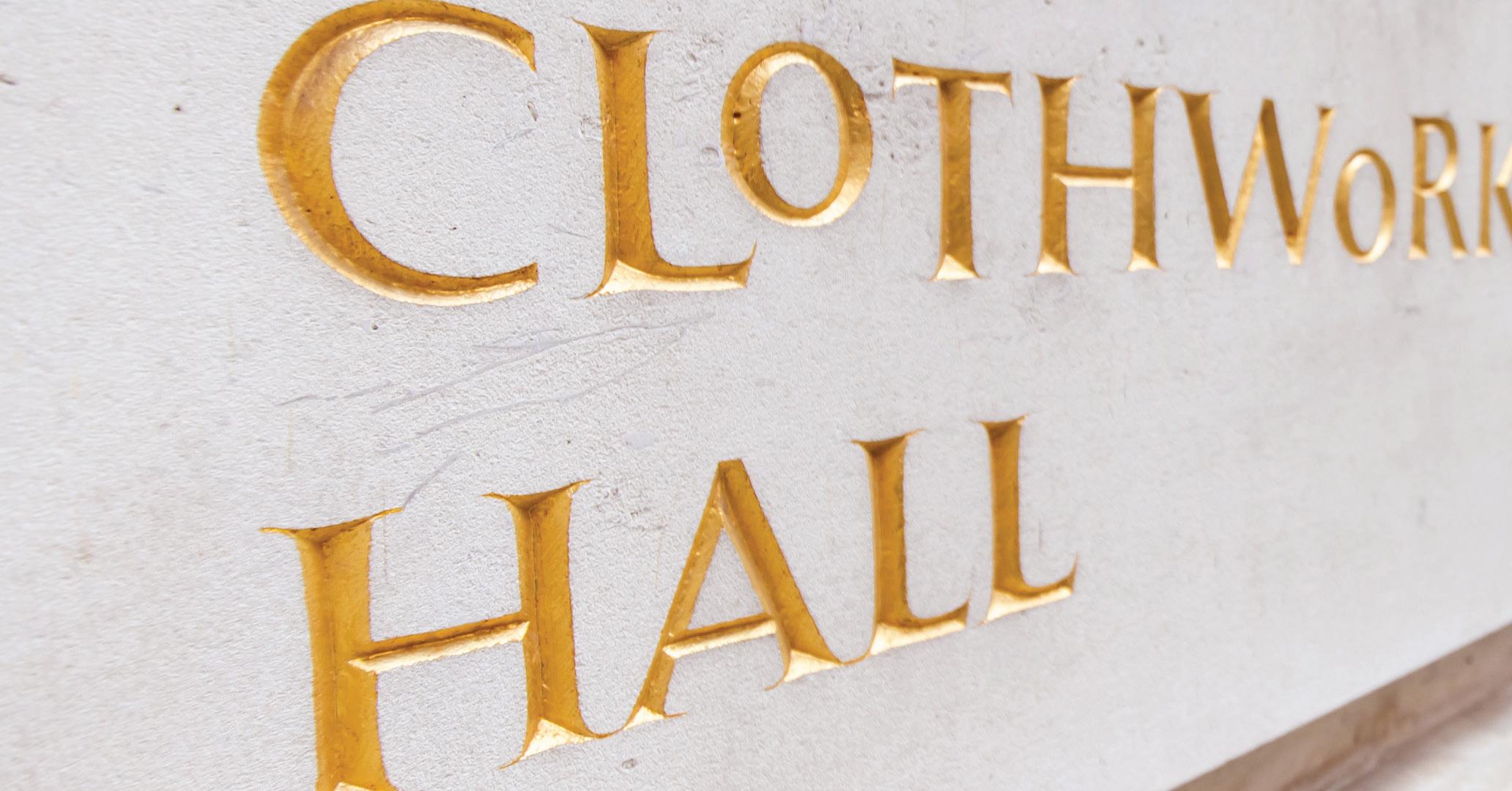
[Oliver passed away in July.]
Henry was born in South Africa and met my sister, Priscilla (a Clothworker since 1963), after he came to study at Cambridge in 1959. They married in 1965, Henry bringing with him an extended family of cousins in the UK as well as South Africa and France. His mother was French, and there were many visits across the Channel when she went back to live there.
Henry trained as a chartered accountant at Cooper Brothers in the City and spent much of his working life with Bunge
While this meant many hours of commuting from his home in Sustead (Norfolk), it was great for him, as a retiree who had the time to give, to be able to continue to use his brain. He retained an interest in the affairs of The Company for as long as he could, despite the challenges of ‘living with Mr P’, as a great friend of mine used to describe it. Henry is remembered by all with love and great affection. Priscilla said of him, ‘One of his (to me) great attributes was his wit and sense of humour (never meant to be
Today, we remember our colleague and friend Oliver Crewdson Howard, who sadly passed away on Sunday, 24 July 2022. Diagnosed with incurable pancreatic cancer shortly after the Jubilee weekend, his suffering was fortunately short lived.
Oliver was the son of Joseph Crewdson Howard (Court Assistant) and joined The Company by Patrimony on 5 November 1969. The Howards’ Clothworker connection is believed to go back to the late 17th century, through the Deane family.
Oliver joined the Livery on 18 July 1973, became a Member of the Court in 2001, Master Excused Service in 2016, and Assistant Emeritus in 2018.
As a Court member, Oliver served on The Company’s and Foundation’s Risk and Audit Committees (Deputy Chair) 2006-9; The Foundation’s Trusts and Grants Committee (later Grants Committee), 2003-28; and was a Governor (later Trustee) of The Foundation, 2001-12. Oliver was a Clothworker through and through, completely committed to the work of The Clothworkers’ Company and proud of his membership and family connections. Service and integrity were important to Oliver, and he was a good communicator with people from all backgrounds.
I n his other life, Oliver was a career soldier, with a spell in the City and then retirement to Somerset, where he enjoyed his love of country
pursuits such as dogs, gardening and local charitable work. His appointment in 2000 to be a member of the Honourable Corps of Gentlemen at Arms renewed his love of all things military, enabling him to take part in great State occasions and exercise his strong social skills.
I remember his kindness to our daughter and a young friend at a Buckingham Palace Garden Party, where he scooped them up, looked after them and introduced them to Prince Michael of Kent (something they will never forget).
On a personal note, I have been a friend of Oliver’s wife, Laura, and her family, the Thompson-Royds, for nearly 50 years. I was thrilled when Oliver and Laura decided to marry in 2004. Anthea and I have been able to enjoy the hospitality of the Old Manse, and they in turn have stayed with us, most recently for a night at the end of March this year. Little did we know this would be the last time we all met.
Our deepest sympathy goes to Oliver’s wife, Laura, and his beloved dogs. We will miss Oliver at Clothworkers’, but can console ourselves that he is out of pain and suffering.
We regret to announce the following deaths:

Annabel James Freedom (April 2020)
Stephen Ward Freedom (2021)
Eileen Coppen Freedom (March 2021)
E Isabel Moore Freedom (September 2021)
Lynn Simmonds Freedom (December 2021)
Susan Hindley Freedom (2022)
Denise Nicholls Freedom (March 2022)
William Hodges Freedom (April 2022)
Derek Harley Freedom (April 2022)
William Houston Livery (May 2022)
Iris Noon Freedom (September 2022)
Announcements include notices missed in the previous publication or those for Clothworkers who have passed since we published our spring magazine.




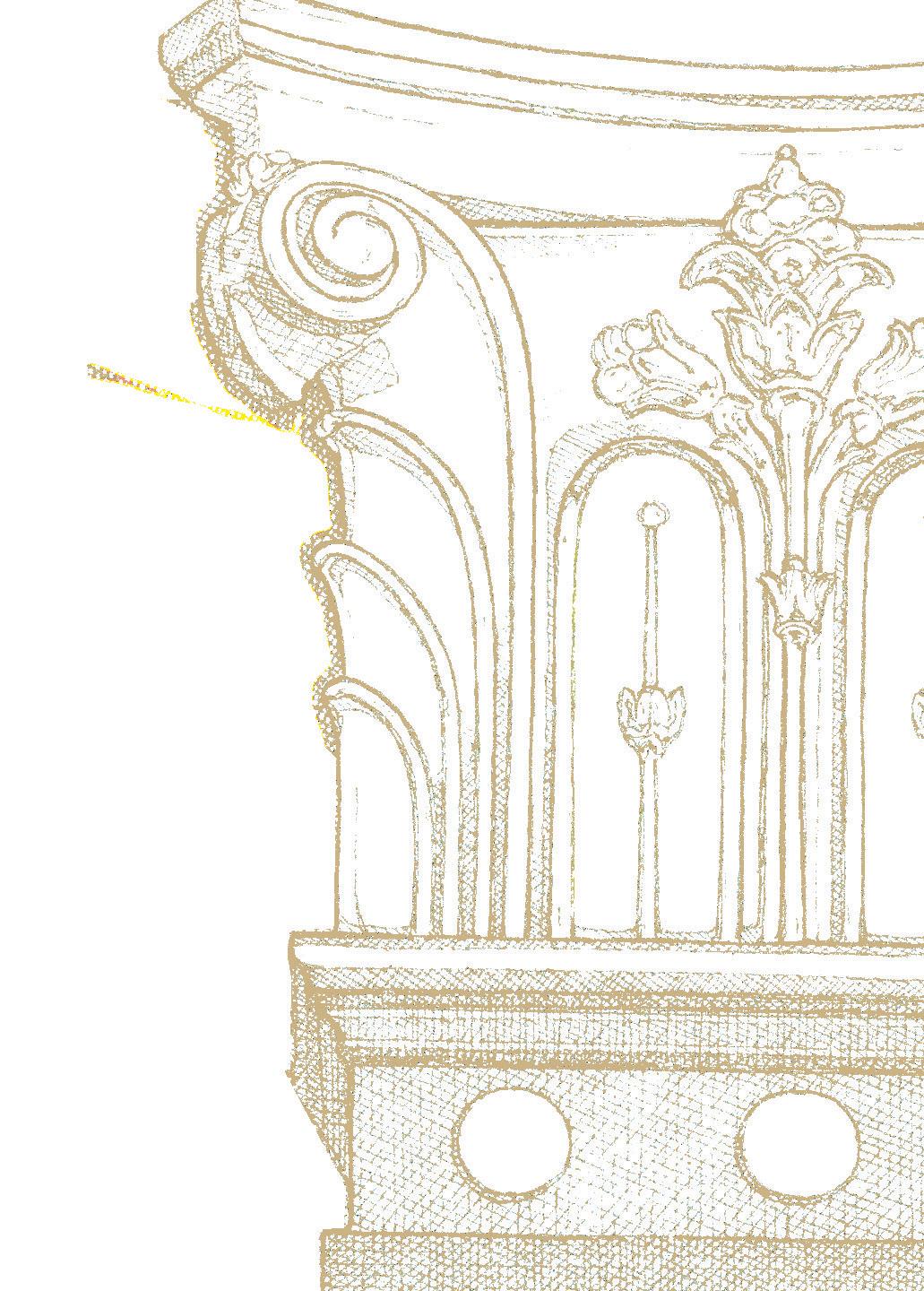
Our mission is to inspire and empower individuals and communities through action, partnership and financial support. We are particularly focused on UK textiles, charity governance, and philanthropy – through The Clothworkers’ Foundation and beyond. We achieve this through:
We are a leading supporter of UK textiles, developing partnerships that enable us to invest in and support education, academic research and innovation, skills development, training, textiles design, heritage and conservation.

Our Members come together in friendship, giving their time and expertise to serve others and to make a positive and sustainable impact in the City of London and beyond – by serving on our Court, as trustees or school governors, and volunteering.
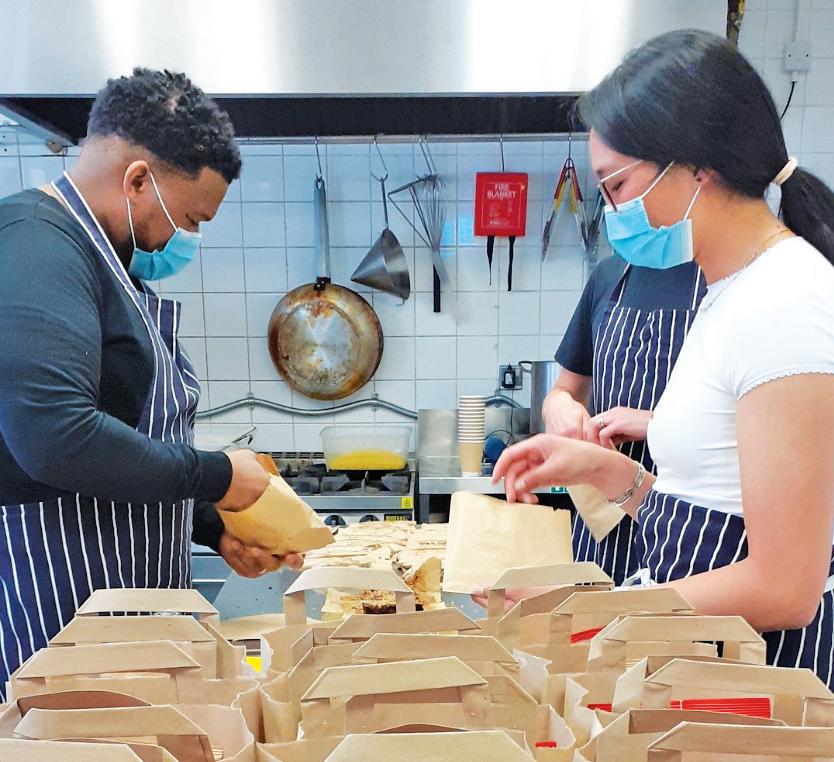
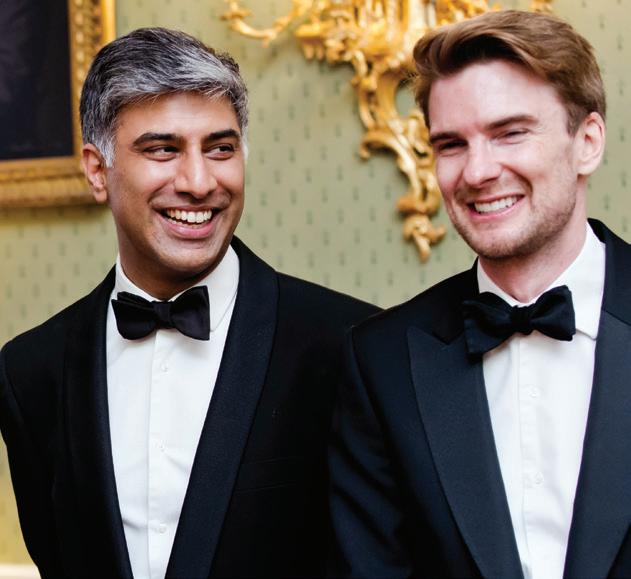

We direct our resources towards promoting opportunity and empowering people and communities. We are able to achieve this through our own initiatives and partnerships with appropriate organisations.